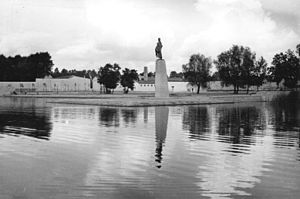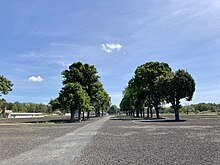Ravensbrück Memorial and Memorial
 Partial view of the Schwedtsee with the sculpture Tragende by Will Lammert (1959) |
|
| Data | |
|---|---|
| place | Fürstenberg / Havel |
| Art | |
| architect | Buchenwald collective (initial design) |
| opening | September 12, 1959 |
| Number of visitors (annually) | around 150,000 (2014) |
| operator | |
| Website | |
| ISIL | DE-MUS-823318 |
The Ravensbrück memorial is a memorial in the city of Fürstenberg / Havel and the district of the former independent municipality of Ravensbrück for the victims of several Nazi camps
- of the Ravensbrück concentration camp
- of the Uckermark concentration camp , for female juvenile prisoners
- and neighboring concentration camps and production facilities as part of SS forced labor
It was opened in 1959 as the Ravensbrück National Reminder and Memorial Center and then expanded several times. The memorial and memorial site has been supported by the Brandenburg Memorials Foundation since 1993 . It is one of the memorials of national and international importance in Germany and is entered in the list of monuments of the state of Brandenburg . An estimated 150,000 visitors came in 2014.
history

The complex of the Ravensbrück concentration camp, built in 1938/39, covered an area of around 200 hectares on the northeast bank of the Schwedtsee in the then independent municipality of Ravensbrück . Of this, the main camp surrounded by the camp wall accounted for about 30 hectares. After the conquest of the area and the liberation of the Nazi camps by the Red Army in April 1945, the area of the former main camp was used as barracks by the group of the Soviet armed forces until 1993 used in Germany and was not accessible to the public.
On September 12, 1959 outside the former camp main camp was with a speech by Rosa Thalmann the National Memorial Ravensbrueck inaugurated. Compared to Buchenwald and Sachsenhausen, it was the smallest of the three national memorials and memorials of the German Democratic Republic , which were designed by the so-called Buchenwald collective . This collective included the architects Ludwig Deiters , Hans Grotewohl (until 1954), Horst Kutzat and Kurt Tausendschön as well as the landscape architects Hubert Matthes (until 1955) and Hugo Namslauer .
The Ravensbrück National Memorial and Memorial was built on an area of 3.5 hectares between the former camp wall and the banks of the Schwedtsee. The center of the facility in Ravensbrück was a memorial place with a platform reaching into the lake on which a stele-like base with the sculpture Carrying by Will Lammert was erected, with Olga Benario as a model. At the entrance to the memorial and memorial is the sculpture Müttergruppe by Fritz Cremer as well as a self-propelled gun (armored tracked vehicle), which commemorates the liberation of the concentration camp by the Red Army . In 1984 a museum was opened in the former camp headquarters after the former cell building had already been used for exhibitions. After the former Soviet, now Russian armed forces withdrew from Ravensbrück in 1993, the former main camp and other parts of the former camp complex were included in the memorial.
Since 2012 there has been a discussion on how to remember lesbian prisoners of the Ravensbrück concentration camp.
Sculptures
Will Lammert : Wearers
Fritz Cremer : group of mothers
getting there
The memorial can be reached via the Fürstenberg / Havel train station (RE 5: Berlin – Stralsund / Rostock), federal highway 96 and the Berlin – Copenhagen cycle route .
See also
literature
- Beßmann, Alyn / Eschebach, Insa (ed.): The Ravensbrück women's concentration camp. History and memory. Exhibition catalog (= series of publications by the Brandenburg Memorials Foundation . Volume 41 ). Metropol, Berlin 2013, ISBN 978-3-86331-122-3 ( table of contents ).
- Hannemann, Simone: The emergence of the national memorial Ravensbrück, 1945-1959 (= Working Papers of the research association SED state . No. 27 ). SED State Research Association, Berlin 1997, DNB 952835355 .
Web links
- Literature by and about the Ravensbrück memorial in the catalog of the German National Library
- Website of the Ravensbrück memorial
Individual evidence
- ↑ Brandenburg State Office for the Preservation of Monuments and the State Archaeological Museum (ed.): List of monuments of the State of Brandenburg - Oberhavel district . D) Monuments of other genres, ID number 09165243, December 31, 2018, p. 22 ( bldam-brandenburg.de [PDF; 276 kB ; accessed on May 13, 2019]).
- ↑ Interest in memorials is growing: Sachsenhausen has more international visitors. In: Der Tagesspiegel . January 26, 2015, accessed April 6, 2015 .
- ↑ a b Federal Agency for Civic Education (ed.): Memorials for the victims of National Socialism. A documentation . Volume II: Federal states of Berlin, Brandenburg, Mecklenburg-Western Pomerania, Saxony-Anhalt, Saxony, Thuringia. Bonn 2000, ISBN 3-89331-391-5 , entry Fürstenberg / Havel , p. 271–275 ( bpb.de [PDF; 23.9 MB ]).
- ↑ The Ravensbrück Memorial. Working Group Confrontations Berlin e. V., accessed April 6, 2015 .
- ↑ Klaas-Wilhelm Brandenburg: What everyone wants and what does not come . In: The daily newspaper: taz . November 3, 2018, ISSN 0931-9085 , p. 51 ( taz.de [accessed on November 29, 2018]).
Coordinates: 53 ° 11 ′ 22.5 " N , 13 ° 9 ′ 51.7" E


